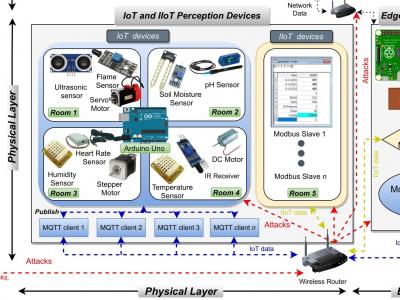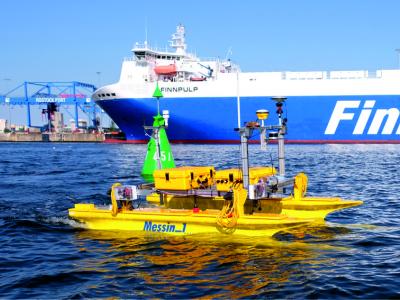Sensors
The proliferation of efficient edge computing has enabled a paradigm shift of how we monitor and interpret urban air quality. Coupled with the dense spatiotemporal resolution realized from large-scale wireless sensor networks, we can achieve highly accurate realtime local inference of airborne pollutants. In this paper, we introduce a novel Deep Neural Network architecture targeted at latent time-series regression tasks from continuous, exogenous sensor measurements, based on the Transformer encoder scheme and designed for deployment on low-cost power-efficient edge processors.
- Categories:
 1272 Views
1272 ViewsIn this project, we propose a new comprehensive realistic cyber security dataset of IoT and IIoT applications, called Edge-IIoTset, which can be used by machine learning-based intrusion detection systems in two different modes, namely, centralized and federated learning. Specifically, the proposed testbed is organized into seven layers, including, Cloud Computing Layer, Network Functions Virtualization Layer, Blockchain Network Layer, Fog Computing Layer, Software-Defined Networking Layer, Edge Computing Layer, and IoT and IIoT Perception Layer.
- Categories:
 23967 Views
23967 Views
These data is used to test the performance of the proposed in-motion inital alignment method.
These data includes the raw data of inertial measurement units, the raw data of GPS and the reference attitude angles.
All these data is simulated.
The frequency of inertial measurement units and GPS are 100Hz and 1Hz, respectively.
The data are explained below:
imu=[gryo;acc;time] Unit is rad; m/s; s
GPS=[lat;lon;height;ve;vn;vu]; Unit is rad; rad; m; m/s; m/s; m/s
Ref_angle=[pitch;roll;yaw]; Unit is rad; rad; rad
- Categories:
 88 Views
88 ViewsThis dataset consists of the training and the evaluation datasets for the LiDAR-based maritime environment perception presented in our journal publication "Maritime Environment Perception based on Deep Learning." Within the datasets, LiDAR raw data are processed using Deep Neural Networks (DNN). In the training dataset, we introduce the method for generating training data in Gazebo simulation. In the evaluation datasets, we provide the real-world tests conducted by two research vessels, respectively.
- Categories:
 1792 Views
1792 Views
There exist several commonly used datasets in relation to object detection that include COCO (with multiple versions) and ImageNet containing large annotations for 80 and 1000 objects (i.e. classes) respectively. However, very limited datasets are available comprising specific objects identified by visually imapeired people (VIP) such as wheel-bins, trash-Bags, e-Scooters, advertising boards, and bollard. Furthermore, the annotations for these objects are not available in existing sources.
- Categories:
 311 Views
311 Views
Cu (II) ion has potential roles in a lot of living metabolisms that its detection and removal are extremely important for flagship branches of science. In this paper, fluorescent and easy-make silica gel immobilized BODIPY were successfully prepared via a simple synthesis procedure for the rapid recognition of Cu (II) ions. The optimal emission and excitation wavelength of the synthesized hybrid material, Si-APTMS-BODIPY, was 543 nm and 460 nm, respectively.
- Categories:
 24 Views
24 Views
We upload the orig.inal measured ecg and impedance data, in xlxs forms, the 1st column is sampling time,the second is amplitude. We use these files and OriginPro to verify the correctness of the model. And use matlab to verify the algorithm's effectiveness.. More information if you needed,, pls connect the following email: 17112020021@fudan.edu.cn
- Categories:
 164 Views
164 ViewsThis dataset is used to design patent. The system is basic , as can be seen from figure.
There is related dataset- Data: 255W Panel Connected 72Ah Li-Ion.
This new datasets are needed to show that I know how to make simulation and the dataset of 'Data: 255W Panel Connected 72Ah Li-Ion' is not fake.
The boost converter, BMS is on existing designs.It is very simple for any graduate,degree holder or school students, so no paper is written for it.
- Categories:
 744 Views
744 ViewsPlease cite the following paper when using this dataset:
N. Thakur, "Twitter Big Data as a Resource for Exoskeleton Research: A Large-Scale Dataset of about 140,000 Tweets from 2017–2022 and 100 Research Questions", Journal of Analytics, Volume 1, Issue 2, 2022, pp. 72-97, DOI: https://doi.org/10.3390/analytics1020007
Abstract
- Categories:
 2819 Views
2819 Views





